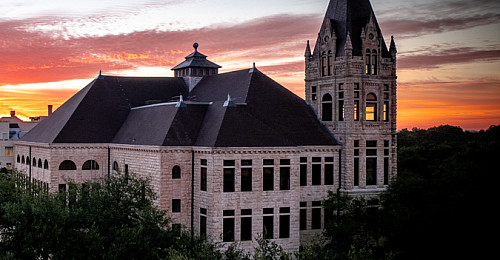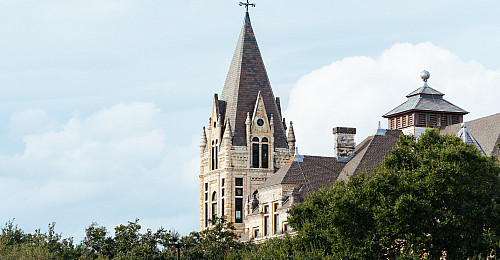Art History
Majoring & Minoring
The curriculum prepares students as international generalists with exposure to a range of courses in Classical, Pre-Modern Latin America, East Asia and Modern, and leads to highly independent interdisciplinary research in the capstone seminar.
- Major in Art History
Major in Art History: 9 courses
- Introduction:
- One Introduction to Art History (any -000 course)
- Distribution:
- One course from East Asian Art and Architecture (any -200 course).
- One course from Latin American Art (any -300 course).
- One course from Pre- or Early Modern Europe or Architectural History (any -400 course).
- One course from Modern Art (any -500 course).
- Electives:
- Two additional courses in Art History, which must be upper-level (-200 or above).
- Upper Level Courses:
- ARH71-614 Special Topics in Art History (to be taken before the capstone seminar.)
- ARH71-824 Capstone Research Seminar (to be taken fall of senior year)
Note on course numbering: 71- indicates art history. -000 level courses are introductory. -200-500 level courses are period and culture courses (-200 East Asia; -300 Latin America; -400 Pre-Modern and Early Modern Europe and Architectural History; -500 Modern Euro-America. -600-800 level courses are upper-level courses. -900 level courses are tutorials, honors, internships, and independent study.
- Introduction:
- Paired Major in Art History and Studio Art (BA)
Paired Major in Art History and Studio Art (BA): 17 courses
Introductory courses:
- One Introduction to Art History course (any ARH71-0X4 course)
- ART68-104 Drawing I
Distribution/Focus courses*:
- One East Asian Art History course (any -200 level course)
- One additional Non-Western Art History course (any -200 or -300 level course)
- One Pre- or Early Modern European Art History course (any -400 level course).
- One Modern Art History course (any -500 level course).
- One Ceramics Course:
- ART68-224 Ceramics I
- ART68-314 Ceramics I
- One Painting Course:
ART68-244 Painting I
ART68-334 Painting II
- One Sculpture Course:
ART68-234 Sculpture I
ART68-324 Sculpture II
- One Studio Art Course from:
ART68-224 Ceramics I
ART68-314 Ceramics II
ART68-244 Painting I
ART68-334 Painting II
ART68-254 Printmaking I
ART68-344 Printmaking II
ART68-234 Sculpture I
ART68-324 Sculpture II
Upper level courses:
- ART68-204 Drawing II
- ARH71-614 Annual Topics in Art History (to be taken before the capstone seminar.)
- ART68-404 Seminar (Note: these courses are offered only once per year)
Elective courses:
- One additional course (3-4 credits) in Studio Art
- One additional upper level course in Art History (level 200+)
Capstones:
- ARH71-824 Capstone Research Seminar (Fall senior year)
- ART68-504 Capstone (Note: these courses are offered only once per year)
Optional senior art exhibition: BA students may seek approval for a senior art exhibition – see the professor in the focus area and the department chair for requirements. Students who are approved must take ART68-512 Exhibition Practicum in the semester of their senior exhibition.
Note: Only one -0X4 level ARH course counts toward the major. Any second -0X4 ARH course counts as a general elective credit.
- Paired Major: Business and Art History
Paired major in Art History and Business: 17 courses
- One Introduction to Art History course (any ARH71-004 course)
- ECO31-104 Principle of Economics
- BUS30-114 Fundamentals of Accounting
- BUS30-214 Foundations of Business
- BUS30-474 Finance
- ARH71-614 Special Topics in Art History (to be taken before the capstone seminar.)
Distribution courses for Art History:
- One course from East Asian Art and Architecture (any -200 course).
- One course from Latin American Art (any -300 course).
- One course from Pre- or Early Modern Europe or Architectural History (any -400 course).
- One course from Modern Art (any -500 course).
Electives:
- Four additional upper-level courses in or contributing to Business or Economics (3-4 credits each)
- One additional upper level course in Art History (level 200+)
Capstones:
- ARH71-824 Capstone Research
- BUS30-964 Capstone in Business
- Paired Major: History and Art History
Paired major in Art History and History: 16 courses
Introductory courses:
- One Introduction to Art History course (any ARH71-0X4 course)
- One World History (any HIS16-0X4)
Area courses:
- One course from East Asian Art and Architecture (any -200 course).
- One course from Latin American Art (any -300 course).
- One course from Pre- or Early Modern Europe or Architectural History (any -400 course).
- One course from Modern Art (any -500 course).
- One upper-level History course from four of the following six areas:
- Africa:
- HIS16-204 History of Africa
- HIS16-314 Topics in African History
- East Asia:
- HIS16-214 History of East Asia to 1800
- HIS16-224 History of East Asia since 1800
- HIS16-324 Topics in Asian History
- HIS16-434 Nomadic Empires: The “Barbarians” of the East Eurasian World
- Europe:
- HIS16-254 History of Early Modern Europe
- HIS16-264 History of Modern Europe
- HIS16-344 Topics in European History
- HIS16-504 History of the British Isles since 1688
- HIS16-514 Modern France and Empire
- HIS16-524 The Real Game of Thrones: The Medieval Era in History and Legend
- HIS16-534 The Tudors: Politics & Culture, 1485- 1603
- HIS16-544 History of Human Rights
- HIS16-554 History of Europe’s Muslims
- Latin America:
- HIS16-234 History of Colonial Latin America
- HIS16-244 History of Modern Latin America
- HIS16-334 Topics in Latin American History
- HIS16-404 Latin American History in Film and Literature
- HIS16-414 The Mexican Revolution
- United States:
- HIS16-274 History of the U.S.: From Colonies to Nation
- HIS16-284 History of the U.S.: From Nation to World Power
- HIS16-294 Texas History
- HIS16-364 Topics in U.S. History
- HIS16-454 History of the Civil Rights Movement
- HIS16-464 Rise of the Right: History of the Conservative Movement in the U.S.
- HIS16-474 Sport and Society in Modern America
- HIS16-484 The History of the U.S. West
- Transregional:
- HIS16-374 Topics in Transregional History
- HIS16-604 Sciences and Its Publics
- HIS16-614 Witches, Nuns, Prostitutes, Wives, and Queens
- HIS16-624 History of the Islamic World
- Africa:
Upper level courses:
- ARH71-614 Special Topics in Art History
- HIS16-854 Historiography
- One additional upper level course in Art History (level 200+)
- One additional upper-level course in History
Capstones:
- ARH71-824 Capstone Research Seminar
- HIS16-864 Research Seminar (Capstone)
Note: One course taken as part of the major must have a substantial pre- or early modern component. Courses meeting this requirement include History 16-024, 16-044, 16-204, 16-214, 16-234, 16-254, 16-274, 16-524, 16-534, 16-614, 16-624.
- Minor in Art History
Minor in Art History: 5 courses
- One Introduction to Art History (any -000 course).
- One course in at least two of the four following areas (2 courses total):
- Asian (any -200 course).
- Latin American (any -300 course).
- Pre- or Early Modern Europe or Architectural History (any -400 course).
- Modern (any -500 course).
- Two additional upper level courses in Art History, at or above the 200-level.
Note on course numbering: 71- indicates art history. -000 level courses are introductory. -200-500 level courses are period and culture courses (-200 East Asia; -300 Latin America; -400 Pre-Modern and Early Modern Europe and architectural history; -500 Modern Euro-America. -600-800 level courses are upper-level courses. -900 level courses are tutorials, honors, internships, and independent study.
- Art Education
See the Education Department for information regarding teacher certification in Art.














